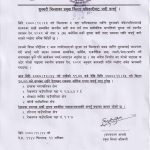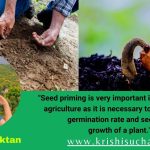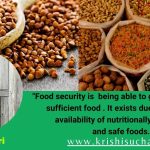The Significance of Quality Seed in Ensuring Food Security and Seed Self-Sufficiency

Introduction
Seed is a type of substance used for planting or regeneration. Seed, on the other hand, is a viable and germinating fertilized mature ovule that contains an embryonic plant, stored food material, and a protective covering. As a result, it is the most important for crop production. Today world’s population is growing, yet cultivable land is shrinking due to urbanization and industrialization, resulting in increased food scarcity. Seed is the most fundamental and important unit in agriculture, as well as the foundation for food security and biodiversity protection. It’s also a way for new technologies and support services to reach rural communities. The seed system is one of the most significant components of the agricultural system, and it plays a key role in agricultural development and poverty reduction efforts. (B.KC, 2020). Similarly, Pure seed with a high germination percentage, devoid of illness and disease organisms, and with the right moisture content and weight are all characteristics of high-quality seed. Quality seeds are essential agricultural inputs for the development of resilient agricultural sectors and food systems that promote food security, nutrition, and farmer livelihoods.
Seed Quality
Seed is said to be quality if it is scientifically produced and is distinctly superior in term of physical, genetic, physiological and pathological parameters. Seed lot should meet certification standard to be of good quality. To end up with a strong crop and good and ample availability of the products, the quality of seeds and young plants is critical. By combining your efforts, you may maximize your revenues. With the correct growing methods, excellent seeds can be grown. Good seeds and young plants also help local farmers make better use of their resources, provide more job opportunities, produce safer and healthier food, and mitigate the consequences of climate change. It ensures that seeds germinate well, emerge quickly, and grow quickly.
Characteristics of Quality Seed
- Physical quality
- Seed should be free of contaminants and clean.
- Inert objects such as stones, mud, husks, and broken seed should be removed from the seed.
- Free from weed seed (objectionable and noxious).
- Free from other crop seed.
- Free from other variety seed.
- Genetic quality
- The seed variety should be accurate to the type (same as parent material).
- There should be no degeneration in the variety’s genetics.
- Physiological quality
- Seed should be big and bold
- High germination percentage
- Optimum moisture content on an average 12% for rice, wheat and maize: 9% for pulses: 8% for oil seeds.
- Pathological quality
- The seed should be in good health.
- Seed should be devoid of disease spores, which can be found in or on the seed.
- Free of bug eggs, larvae, and adults
- Treated with chemicals like vitavex, thiram
Quality Seed as a solution to Food Security and Seed Self- sufficiency
Food security has been described in a variety of ways, but the 1996 World Food Summit presented one of the most frequently accepted definitions: “Food security exists when all people ,at all times, have physical and economic access to sufficient, safe, and nutritious food that meets their dietary needs and food preferences for an active and healthy life.” It entails having enough food to consume on a regular basis, not only today and tomorrow, but also next month and next year. Food security, according to the United Nations’ Food and Agriculture Organization (FAO), is the result of food availability, food access, supply stability, and biological utilization (Nations., 2001.) Similarly, self sufficiency is the quality or condition of being self- sufficient. In other word, it is the capable of maintaining oneself or itself without outside aid. Higher the quality contain in seed, the more will self sufficiency as quality seed gives high quality produce; fetches high market price and it reduces the amount of seed requirement by almost 25%.During the recent economic downturn, the concept of food self-sufficiency (which limits the role of imports to food products) became increasingly essential. Many countries considered it to be one of the most important issues of the time, their agri-food programs’ top priorities (Baer-Nawrocka, 2019). Self-sufficiency in food is a subset of the greater subject of food security. “Food self-sufficiency is commonly regarded to mean the amount to which a country can satisfy its food demands from its own domestic production,” according to FAO (FAO, 1988). This definition, on the other hand, emphasizes a country’s, region’s, or household’s ability to meet its own food demands. Food self-sufficiency is usually described in terms of staple food crops, such as rice and wheat, cereals and root vegetables.
Producing high-quality seeds is a powerful instrument for addressing self-sufficiency, food security, and economic development concerns. Food self-sufficiency is one of the most important contributors to food security, and food security and seed security are inextricably linked. As a result, we can clearly state that seed security, in addition to seed self-sufficiency, is essential for food security and self-sufficiency. Plants grown from high-quality seeds develop faster, reducing the time between planting and harvest, allowing farmers to maintain optimal crop rotation and enhance productivity throughout the year. Input efficiency may be proved, and quality seeds have superior crop standard qualities, all of which contribute to food security. Uncertified local seeds have low vigor and a variety of physiological and pathological flaws. If such seeds are used without proper inspection or investigation, output will be limited, leading to food poverty. As a result, using high-quality seed is critical to guaranteeing food security. Quality seeds of popular high yielding or hybrid types are the seeds that farmers prefer to cultivate. If bad seeds are replaced with good and quality seeds, agricultural productivity will skyrocket. Farmers will be enthused and benefited by the replacement of bad seeds with excellent seeds. Given the poor quality of farmer-saved seeds, the availability of high-quality seeds would not only enhance seed replacement rates, but will also aid seed saving by allowing for a lower seed dose per unit area (Hasanizzaman, 2015). Making the country self-sufficient in quality seeds or making quality seeds available to farmers will undoubtedly meet the country’s food demands, putting the country on the road to food security and seed self-sufficiency.
Despite countless efforts to strengthen seed systems in developing nations like ours, the seed sector in these countries continues to face significant obstacles. The high cost of seed production and processing, the restricted reach of mechanization, and the inadequate adaptation of conservation agriculture technologies are the most pressing concerns in seed systems. Farmers in our country do not have adequate access to quality seeds, so they rely on uncertified local seeds, which are less productive than quality seeds, posing a major impediment to agricultural productivity and, at the same time, a threat to food security and self-sufficiency.
Many institutions, as well as the government, must promote the production of high-quality seed and ensuring that it reaches every farmer in every corner of Nepal. As a result of the numerous initiatives that are now underway in the city, Food Security and Agricultural Project Analysis are two of the most important issues in Nepal’s agriculture. Going on for the “New Normal” can be even easier with the help of the Emergency Services Assistance Program (ESAP), working together on such projects. National Seed Company Limited (NSCL), Nepal Agricultural Research Council (NARC), and others are among them. One of the most reliable parts supporting for sustainable seed sector is co-operation of such enterprises, formation of even more policies, and even more innovations and investments, as well as the Ministry of Agricultural Development has established a National Seed Vision 2013-2025.
Conclusion
During this time, Nepal’s seed supply system has completely disintegrated. As a result, one of the most often accepted strategies for resolving food insecurity during this period is the availability of quality seed. Seed revolutionization is required to implement preparedness measures in the agriculture sector. So that people do not have to deal with food shortages, hunger, or a scarcity of cultivable resources. People must embrace “New Normal” or “Healthier Normal” lifestyles for a better and more sustainable environment. Thus, in order to achieve food security, we must now concentrate on increasing agricultural output, which necessitates the use of high-quality seed.
References
B.KC, H. &. (2020). Quality Seed For Food Security And Food Self- Sufficiency During Havoc Of Covid-19 In Nepal. Tropical Agroecosystems(TAEC) , 80-87.
Baer-Nawrocka, A. S. (2019). Food security and food self-sufficiency around the world: A typology of countries. PLoS ONE .
FAO. (1988). Developing seed security strategies and programs for food security in developing countries’, Proceedingsof the International Workshop on Seed Security for Food Security. Seed and Plant Genetics Resources Service .
Hasanizzaman, M. (2015). Seed quality.
Nations., F. a. (2001.). The State of Food Insecurityin the World 2011. Food and Agriculture Organisation: Rome, Italy .
Writer: Chanda Adhikari (Student, Bsc Ag 4th Semester, IAAS, Paklihawa Campus)

 एउटा यस्तो विषालु भ्यागुता, जसको मुल्य नै पर्छ ३ लाख, जान्नुहाेस्
एउटा यस्तो विषालु भ्यागुता, जसको मुल्य नै पर्छ ३ लाख, जान्नुहाेस्  भोलि र पर्सि बालबालिकालाई भिटामिन ए खुवाइदै
भोलि र पर्सि बालबालिकालाई भिटामिन ए खुवाइदै  खगराज अधिकारी गण्डकीको मुख्यमन्त्री नियुक्त
खगराज अधिकारी गण्डकीको मुख्यमन्त्री नियुक्त  सुनसरीमा दुवै पक्षबीच सहमति, कर्फ्यु खुकुलो हुदै
सुनसरीमा दुवै पक्षबीच सहमति, कर्फ्यु खुकुलो हुदै  स्टेफेनको शतकमा आयरल्याण्ड वोल्भ्सले नेपाल ए लाई दियो २८५ रनको लक्ष्य
स्टेफेनको शतकमा आयरल्याण्ड वोल्भ्सले नेपाल ए लाई दियो २८५ रनको लक्ष्य 


